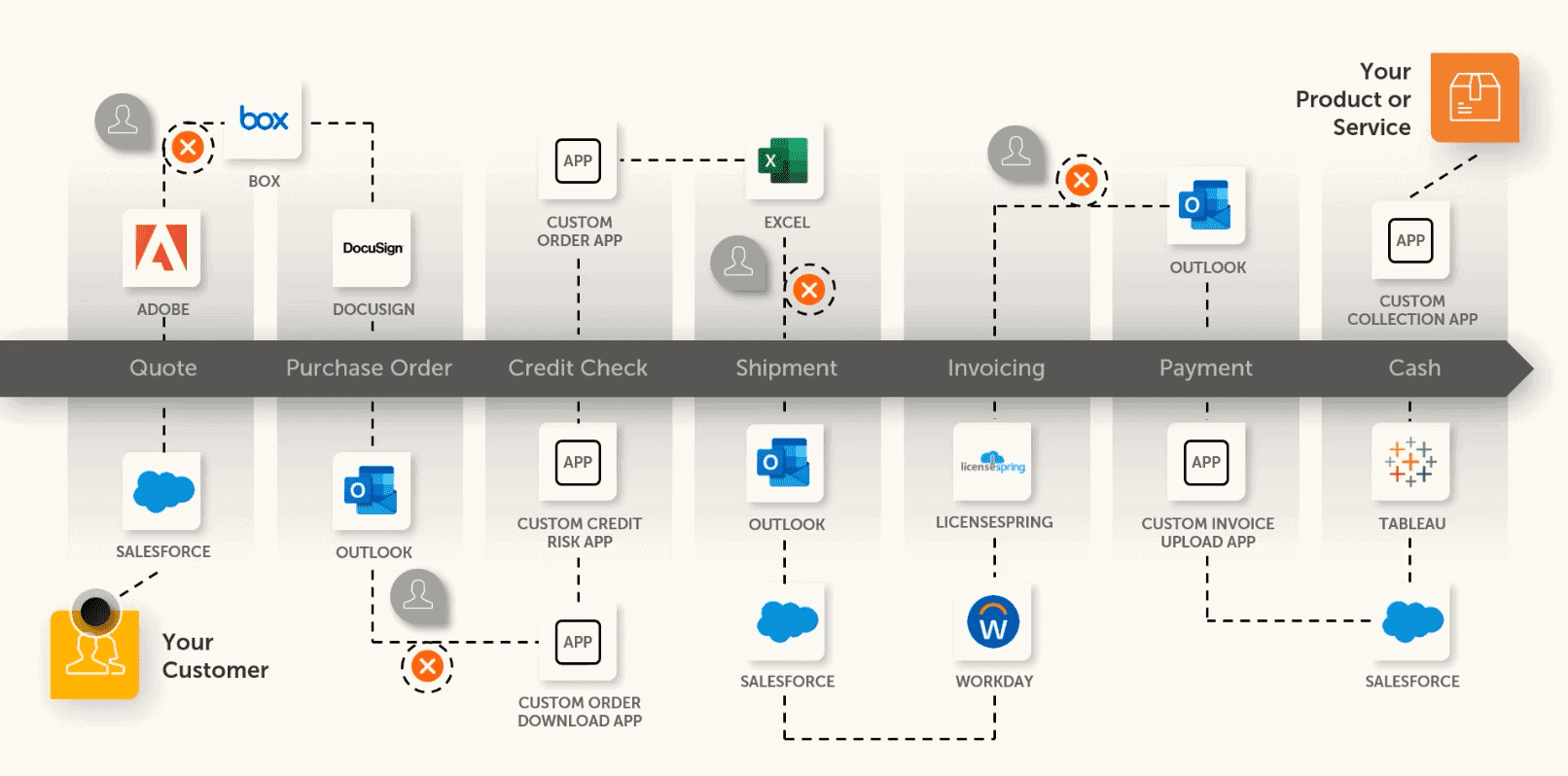The 4 Step Approach to Automating End-to-End Processes
Can end-to-end automation be achieved in a dynamic business process with multiple moving parts? We’ll show you how this endeavor is more than possible with robotic process automation.
End-to-End Automation for Complex Processes
Many businesses today fall victim to the “automation web trap” when beginning their robotic process automation (RPA) journey. Meaning, while they recognize the benefits RPA can bring to their mundane business process, and may even be automating at a small scale, they still have barely scratched the surface as to what’s really possible.
Unfortunately, many RPA projects stop at small scale (or are unsuccessful completely), because of the poor approach taken to automating more complex processes. In the majority of businesses today, there are multiple departments working with various applications and legacy systems on a daily basis. Often, there is overlap among these “swim lanes” to accomplish even the most simple task, like data entry or validation requests. In fact, the average bank has over 3,000 applications in their enterprise landscape!
This sporadic landscape can especially hinder the customer life cycle when unique inquiries or requests come through. Here is an example of the average business process, and what different applications/systems are involved in one of these instances:
The big question is – why are organizations trying to remedy complexity with MORE complexity? Can’t the automation journey be streamlined, simplified and scaled in a shorter amount of time?
Abhijit Kakhandiki, Automation Anywhere EVP and Product Engineer, gave an insightful keynote on this subject during this week’s Imagine Digital Live-stream event, which we’ll detail here. Simply put, businesses wishing to achieve full scale, end-to-end automation capabilities within their organization’s processes need to adapt a 4-step approach to implementation, which Automation Anywhere solutions can assist with.
Step 1. Discover
According to Automation Anywhere, 65% of a businesses’ automation journey is spent trying to figure out what processes are candidates for automation. So essentially, more than half of the journey is spent examining the people, processes and technologies utilized across disparate channels, before any implementation work ever begins. Further, when identifying candidates, various stipulations need to be considered:
Discovery Bot is the remedy to this problem. Through the AI-driven capabilities of Discovery Bot, a 30 day automation assessment for example, can be achieved in just hours. This bot uses artificial intelligence to identify what processes are prime candidates for automation based on the ROI to the business.
Discovery Bot ingrates with your existing platforms to essentially record and examine the inner-workings of various daily processes. Based on these recordings, this bot maps a workflow of the various applications used in a process, and automatically creates bots to streamline the tasks that are most time consuming, require multiple mundane steps, and will free up the human workforce for more innovative tasking. Essentially, AI-driven automation is identifying other candidates for automation, transforming complexity into efficiency.
Step 2. Capture
Currently, the majority of businesses still house and reference unstructured data. This can be problematic when starting your RPA journey, and moving from the identification phase to the integration phase. Here are some major areas/functions that rely on data for an efficient automation implementation:
Capturing and feeding this data to the right processes within these functions is critical for a scaled RPA implementation. Knowledge workers, who are responsible for managing data within complex business processes, often endure the painstaking task of manually retrieving this data to ensure it’s not hidden from RPA bots. Through technologies like IQ Bot, there’s a much easier and efficient solution.
IQ Bot combines the solutions and capabilities of RPA with AI-drive technologies, such as fuzzy logic, machine learning and natural language processing (NLP). Through this combination, data and information can be extracted, classified and validated as it pertains to a given process in the business, making an end-to-end automation integration possible.
Step 3. Automate
RPA implementations are more prone to failure when businesses attempt to start at this step, ignoring the discovery and capture phase of the process. Once you have identified candidates for automation through an ROI approach, and harnessed essential data through intelligent data gathering methods, it’s time to onboard the digital RPA workforce. Here are some critical steps in this phase of the integration:
Step 4. Optimize
Full-scale RPA integrations only reach their full potential when processes become not only automated, but intelligent and adaptive. Intelligent bots generate data that can be harnessed and applied to other areas in the business, helping them understand the inner-workings of existing processes that much better. This can be achieved with Automation Anywhere’s analytical platform, Bot Insight.
Bot Insight is an intelligent analytics platform that provides real-time and interactive insights into the bots operating within an automated process. Bot Insight analyzes the bots that exist within a given process, retrieves the data generated by these bots, and translates the data into an easy to read, fully customizable dashboards. This tool not only helps you measure the performance of your RPA integration, but gives you the ability to predict and solve preventable business problems.
Crawl, Walk, and Scale!
In a very short time period, RPA has taken significant strides in the scalability and enhancement of even the most complex business processes. Through pairing machine learning and artificial intelligence with RPA technology, bots are used to not only streamline mundane processes, but identify automation candidates within a business, and harness intelligent data for future use. Through an end-to-end automation integration, businesses can achieve the full spectrum of digital transformation.
Missed the Automation Anywhere Imagine Digital event? Watch the Recordings:
Looking for more on RPA?
Explore more insights and expertise at smartbridge.com/automation
There’s more to explore at Smartbridge.com!
Sign up to be notified when we publish articles, news, videos and more!
Other ways to
follow us:



